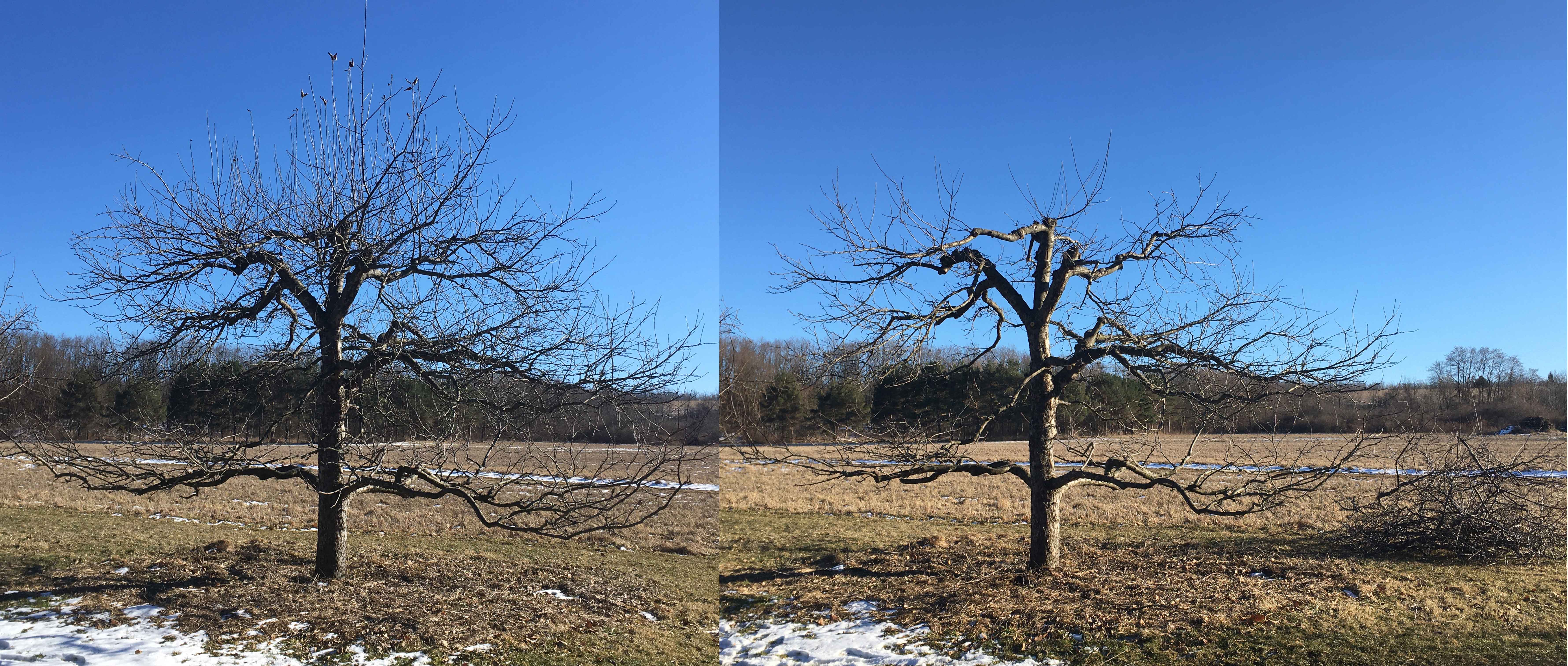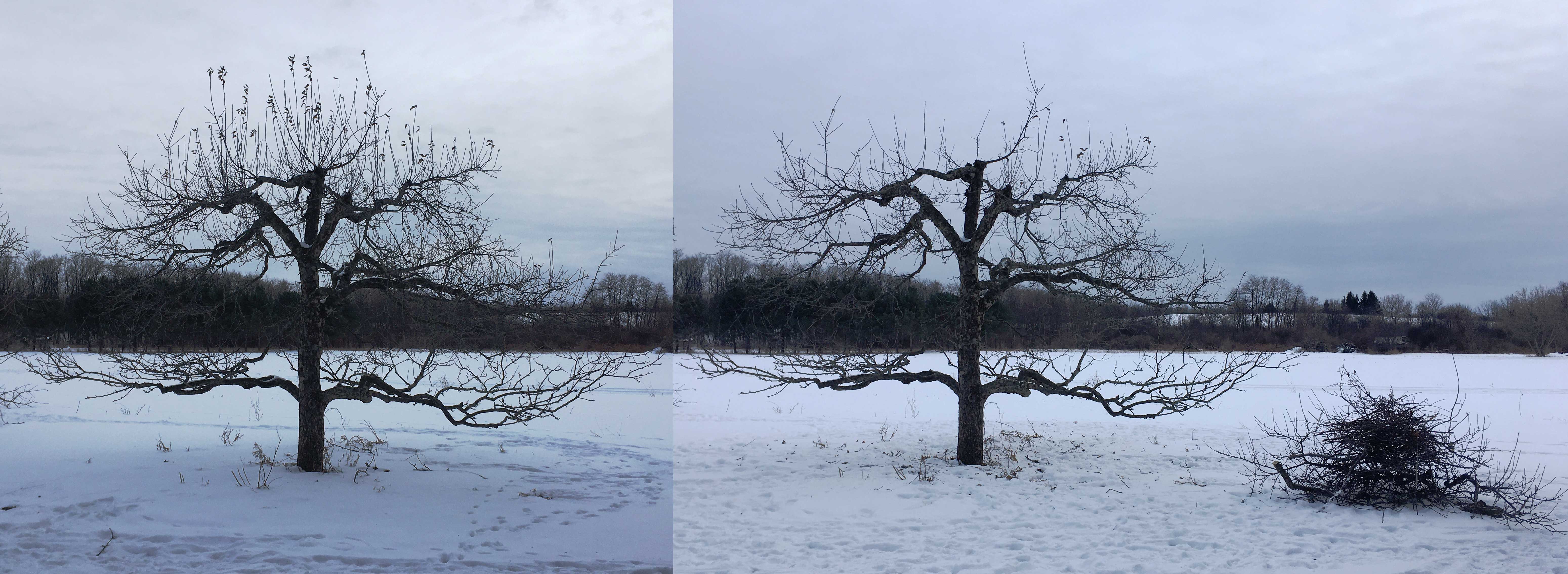

A fruit tree is both a delicate and precious source of life, and a commonplace pest in frequent need of discipline. I've found that most fledgeling orchardists tend towards the over-delicate view, fear too much "hurting the tree" by cutting it. This is not the case. I encourage you to develop a certain callousness to the imagined suffering that you project onto the tree.
To begin with an explanation of why pruning is necessary: a fruit tree is no longer a wild thing. Like any domesticated species, it has been bred to produce things we like, and in turn to require our guidance and protection. The most obvious way this manifests is in the tree's tendency to become tangled and overgrown. This is bad for the tree in a number of ways: the branch tips can become too heavy and break, a lack of airflow can harbor molds and other diseases, and the lower branches (which are more convenient to pick) become shaded out by higher ones. Thus, every year, usually in winter, some sizable fraction of the tree's limbs and twigs must be removed. Usually between about 15 and 30%.
The confusing thing about pruning is how many different "rule sets" there are about it. Switching between them requires a kind of mental flexibility that can be difficult at first, but comes with time and experience. Witnessing the resilience of the trees themselves and their responses to your cutting will be your best teacher in the ongoing process of choosing which of these principles to prioritize.
Here is a common sequence to all the methods that follow: Begin by walking a full circle around the tree, taking its view from a good distance, and choose your largest cuts first. These are the cuts that will shape the overall structure of the tree, limbs over three inches diameter. Begin with the large cuts, and work your way smaller. Pause every once in a while and re-assess from a distance to get a sense of the tree's balance and proportion. Occasionally, especially if a tree has been well pruned in the past, there may not be any big cuts. But there's usually at least one.
The next most universal rule of pruning, is to cut any limb that is "dead, damaged, diseased, or crossing." It's helpful to apply this rule before the others, because it can alleviate the need for thinking later.
Dead branches are fairly easy to spot, they are brittle, and when you cut them the exposed cut will not have the green, wet look that live cuts have. You can try to snap off a twig near the tips to check: if it bends and holds on, it's live, if it snaps easily, it's dead.
Damaged branches are ones that have torn partially, but are still hanging on. They cannot be saved. There is an important exception to this, which is sun-scald. Sun-scald is an injury you will only discover once you climb the tree: branches in the crown that look healthy from the ground will have their sun-facing bark completely withered away, with dry heartwood exposed. This form of "damage", even though it looks severe (there is often a kind of smoky blackening around the area) doesn't bother the tree much, and these limbs can remain healthy and productive for many years.
Diseased tissue can be harder to spot, especially in winter when the leaves aren't there to show their symptoms. Look for discolorations of the bark, and deadness or darkening of the tips. You will have to learn what pests and diseases are specific to your area.
Crossing branches are two whose bark is rubbing against each other. One or both of those sections of bark will be damaged, and they won't be able to grow well in contact with each other, so you select the better branch to keep, and cut the other.
The principle of freeing up crossing branches then becomes the main criteria for pruning as you work further. The aim, the ideal condition of a branch, is to have good free open space around it; for air to flow, for light to reach, and for leaves and flowers and fruit and new growth to expand into. In winter, picture the summer's growth adding six inches of leafy growth around every branch.
At this point, you will begin to face tough decisions. When two branches want to occupy the same space, which to choose? Now I will introduce several theories of pruning: ways of looking at the tree. When one rule set doesn't indicate an obvious choice, just switch to another! Each has beneficial influence on the tree, and you can't go that far wrong with any of them.
1. The shape theory of pruning. This is where you have an imagined ideal shape for the tree, and you encourage the branches where you want them, and cut them where you don't. "Encourage" mainly means to create space around a branch for it to grow into, and to give it light if it's too shaded from above. These ideal shapes can include distinct "layers" or "levels", with the lowest spreading widest, and each successive layer a little smaller.
It should include some thought to making the tree pleasant to work in: someone will spend a few hours in each tree every year: pruning, thinning, and picking, so create an easy tree to climb: a tree with convenient ladder placements, a tree that doesn't slap you in the face or stab you in the back with awkward branches. Don't cut off all the low branches that serve as climbing footholds.
You will notice that trees rarely abide by textbook growth patterns. Different cultivars demonstrate different patterns, some spreading, some tall, some growing in a low Y, varying branching angles. Try to see what the tree wants to do, and don't fight it too much.
2. The horizontal-vertical theory of pruning. The important thing to know here is that in general, horizontally-growing wood is fruiting wood, and twigs shooting straight up are "suckers" or "water shoots", and are not desirable, and won't fruit until they are weighed down and begin growing sideways. As I understand it, something happens in the branch when it feels weight on the tips, which tells it that it's fruitwood, and should behave as such. Branches that grow straight down or hang too low are also less than ideal. The rule is: prioritize arcing and horizontal branches over vertical ones.
3. The age & seniority theory of pruning. You can distinguish an old twig from a young one by sight: the young one will be straight and smooth and vigorous and flexible, the old one will be knurled and crooked and have a surface of many dark ridges. The best fruiting wood is between these extremes. Take away the oldest wood, and much of the young, except what you want to become next year's middle-aged.
4. The "encourage growth" vs "rein it in" theory of pruning. With young trees, you will be eager to see them expand. With mature, overgrown, or tightly-spaced trees, you will always be wishing they were smaller. For saplings, picture the small branches once they grow to 6" in diameter. Will they be spaced too tightly then?
When reining it in, try to encourage growth closer in along a branch, rather than all out at the tips. The surface of bark everywhere on the tree contains "latent buds" that can sprout in response to sunlight, so offer it some where you hope to see a branch.
5. The bud orientation theory of pruning. This applies to the small snips you make on new growth: vigorous young twigs under a quarter inch diameter. These twigs can grow a lot every year, perhaps a foot or more, and will tend to continue growing straight until they are pruned, at which point they will change course and take off in the direction of the last viable bud. Buds usually alternate on opposite sides, so pay attention to which way you want the branch to grow, and choose a healthy-looking bud that's facing the direction you want the branch to go, and then cut a quarter to a half inch beyond that bud.
Words of caution: Watch out for grafts. All modern fruit trees are grafted where the roots meet the trunk: rootstocks are bred for certain qualities, fruit varieties are bred for others. The crown and root are then spliced together by the nursery in a frankenstinian union, invisible, except in young saplings, or instances where root suckers arise. But there is another place where grafting occurs: on mature trees where a particularly healthy tree is chosen to host branches of another variety with more desirable fruit. The orchardist cuts off the original branch to a stub, and grafts on a twig from a different cultivar. With luck, the donor limb survives and flourishes. Such grafts can be spotted with practice by noticing abrupt changes in the bark surface, or, in summer, changes in the fruit character. Grafts are considered precious, and given priority over other branches. Make sure not to cut them off, which you may be inclined to do by instinct if they exhibit an irregular growth pattern compared to the rest of the tree.
To conclude, I encourage you to just get practice sooner rather than later. Mistakes are not tragic, and are often the only way to learn.